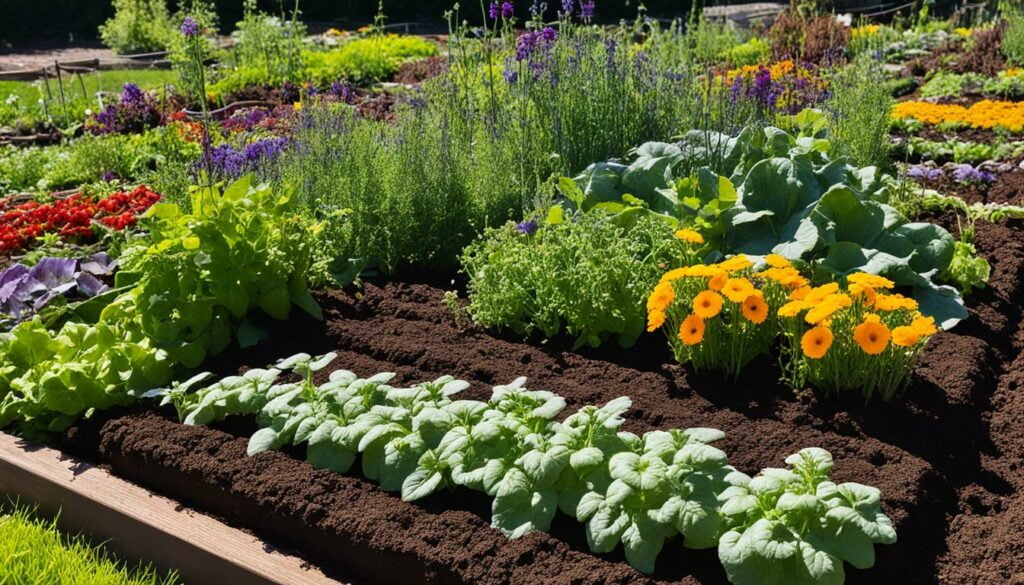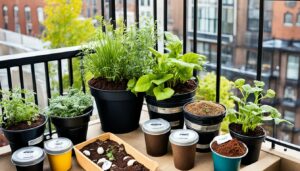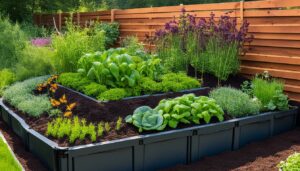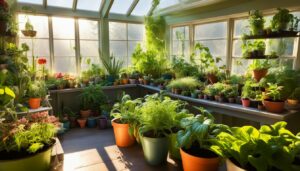Imagine a symphony where each note supports the next, creating harmony that resonates through the air. This is the essence of companion planting, a practice tantamount to orchestrating nature’s own melodies within our gardens. With each plant’s unique characteristics playing a pivotal role, we weave a tapestry of growth where the collective thrives beyond the individual. This time-honored technique illuminates a pathway to bolstering garden health and enhancing garden yield, where nurturing connections between plants leads to a vibrant and resilient ecosystem; a place where the benefits of companion planting become a tangible symphony of abundance.
The journey into companion planting is not merely about the utilitarian aspects of maximizing space or combatting pests. It is a deeper communion with the earth–a gesture towards the profound respect for balance and interconnectedness. Those who have delved into the heart of their gardens understand that these advantages extend beyond the soil and the root; they touch something elemental within us. The practice is a lesson in patience, observation, and ultimately in the celebration of life’s intricate dance.
Whether your hands are seasoned with the soil of years or new to the gentle firmness of the spade, the allure of crafting a garden where each plant augments the strength and vitality of its neighbor is undeniable. Let us explore together how companion planting can be the secret to unlocking your garden’s potential, where the beauty of nature’s relationships transforms your haven into a cornucopia of health and productivity.
Key Takeaways
- Discover how companion planting can create a healthier, more productive garden ecosystem.
- Learn strategic plant pairings for mutual benefits and garden yield enhancement.
- Understand how to utilize natural plant relationships for improved garden health.
- Achieve a flourishing garden by recognizing beneficial and antagonistic plant interactions.
- Embrace the deep connection with nature through the practice and benefits of companion planting.
- Experience the joy of fostering a living, breathing community within your own garden space.
An Introduction to Companion Planting
Companion planting, a time-honored technique among gardeners and farmers, leverages the benefits of companion planting to forge mutually beneficial relationships among plants. This strategic approach not only improves garden productivity but also plays a pivotal role in enhancing soil health. Through close proximity planting, usually within two to three rows, plants aid each other in ways such as pest control and resource sharing, leading to a more fruitful harvest.
Real-life applications such as The Three Sisters paradigm exemplify the efficacy of companion planting for vegetables. This trio of corn, beans, and squash benefit one another — corn stalks act as supports for climbing beans, beans fix nitrogen in the soil to nourish their companions, and squash sprawls across the ground, shading out weeds. Conversely, it’s vital to avoid detrimental plant interactions, like onions stunting the growth of beans, by understanding and practicing mindful planting strategies.
Let’s delve deeper into these relationships with a table that outlines recommended companion plantings and their expected benefits:
| Plant 1 | Plant 2 | Benefits |
|---|---|---|
| Tomatoes | Basil | Enhances flavor, repels flies and mosquitoes |
| Carrots | Chives | Improves growth, deters aphids |
| Cucumbers | Nasturtiums | Attracts pollinators, repels cucumber beetles |
| Peas | Mint | Repels pests, improves health |
| Corn | Beans | Beans climb cornstalks, help fix nitrogen in soil |
| Lettuce | Marigolds | Deters rabbits, adds aesthetic appeal |
By tapping into the benefits of companion planting, gardeners can create synergistic environments that deter harmful insects, attract beneficial ones, and make the most efficient use of space. These advantages collectively contribute to a more productive and healthy garden ecosystem.
Maximizing Garden Productivity with Companion Planting
Gardeners worldwide are turning to companion planting as a strategy to enhance garden productivity and make the most of every square foot. By understanding and implementing time-tested techniques like space-saving companion planting and The Three Sisters method, bountiful harvests are achievable even in the smallest of spaces.
Intercropping Strategies for Small Gardens
Space-saving companion planting techniques such as intercropping can have a remarkable impact on garden output. Intercropping involves planting a combination of crops that have different growth cycles and sizes, creating a diversified and efficient garden ecosystem. Placing slow-growing plants like peppers alongside fast-growing greens maximizes the usage of space over time, enhancing garden productivity considerably.
The Three Sisters Garden: A Model of Companion Planting
The Three Sisters method is a prime example of companion planting done right. This Native American farming technique of planting corn, beans, and squash together leverages the natural properties of these plants to support one another, leading to a well-rounded harvest. Corn provides a structure for beans to climb, beans fix nitrogen in the soil to nourish the corn, and squash’s sprawling leaves shade the soil, conserving moisture and deterring weeds.
Companion Planting in Container Gardens
Companion planting benefits for garden productivity aren’t limited to those with traditional garden plots. Container companion planting allows individuals with limited space, such as balconies or small patios, to enjoy the rewards of a thriving garden. Combining herbs like basil with vegetables such as tomatoes and peppers in the same container not only saves space but also encourages vigorous growth due to their compatible nature.
Benefits of Companion Planting for Soil Health
The fundamental idea behind companion planting benefits for soil health is that it promotes a symbiotic environment where each plant actively contributes to the amelioration of soil conditions. This age-old practice, often overshadowed by modern agricultural approaches, is steadily regaining significance as gardeners rediscover its critical role in improving soil through companion planting.

When plotted thoughtfully, companion plants act as natural tillers, their diverse root systems penetrating the soil and thus alleviating soil compaction. Some plants, like marigolds, even exude substances that can break down nematodes, enhancing the soil’s structure and fertility. The resulting loose, nutrient-rich soil not only fosters healthy plant growth but also improves water absorption and retention.
- Deep-rooted vegetables (e.g., tomatoes, asparagus) reach into the lower soil layers, drawing up nutrients and making them available to shallower-rooted companions.
- Leafy greens and herbs, with their dense root networks, help prevent soil erosion, contributing to the soil’s structural integrity.
- Legumes add nitrogen to the soil through nitrogen-fixation, a boon for nitrogen-hungry plants such as corn and wheat.
| Tapped Element | Deep-Rooted Plant | Beneficiary Companion |
|---|---|---|
| Nitrogen | Beans | Corn |
| Phosphorus | Sunflowers | Onions |
| Potassium | Tomatoes | Basil |
| Calcium | Spinach | Peppers |
Aside from creating a nutrient-rich soil environment, the principles of companion planting often include crop rotation, which in itself is a means of preventing soil depletion and the spread of soil-borne diseases. By embracing soil compaction alleviation and enhanced nutrient profiles, gardeners can expect a robust yield season after season without resorting to artificial fertilizers or interventions.
Benefits of Companion Planting for Pest Control
The enduring quest to maintain a flourishing garden often encounters the hurdle of pest management. However, this challenge can be met with eco-friendly tactics through the practice of companion planting. Offering an array of companion planting benefits for pest control, gardeners can naturally protect their bounty without resorting to harmful chemicals.
Natural Pest Deterrence with Herbs and Flowers
Among the myriad of strategies, the inclusion of specific herbs and flowers stands out for natural pest deterrence. Plants such as dill, marigolds, and basil not only imbue the garden with their vibrant colors and fragrances but also serve a dual purpose. They act as a natural shield, repelling various pests who find their scent unappealing, while simultaneously attracting beneficial pollinators that contribute to a garden’s vitality.
Biological Pest Control: The Role of Predatory Insects
Biological pest control is a cornerstone in sustainable gardening practices. It leverages natural predator-prey relationships to keep pest populations in check. Predatory insects like ladybugs and lacewings are champions of this approach, hunting down pests such as aphids. Their presence in a garden is a testament to the effectiveness of biological pest control, highlighting nature’s own method of maintaining balance.
Trap Cropping as a Pest Management Strategy
Trap cropping is a strategic maneuver in the gardener’s arsenal against pests. This method involves planting a ‘trap’ crop to entice pests away from the main garden attractions. The trap plants, often more appealing to pests than the primary crop, serve as a sacrificial pawn in safeguarding the garden’s primary yield.
Understanding these companion planting strategies not only aids in the development of a robust garden but also fosters an ecological balance that supports both plant and insect communities. Below is a table that illustrates some effective companionship pairings and their target pests:
| Companion Plant | Attracts or Repels | Target Pest | Beneficial Insect Attracted |
|---|---|---|---|
| Basil | Repels flies and mosquitoes | Whiteflies | Hoverflies |
| Marigolds | Repels nematodes and whiteflies | Tomato Hornworm | Parasitic wasps |
| Nasturtium | Traps aphids and beetles | Aphids | Ladybugs |
| Dill | Repels aphids and spider mites | Cabbage Looper | Lacewings |

By integrating these plants within your garden layout, you achieve much more than a tapestry of greenery; you harness the power of companion planting benefits for pest control, ensuring your garden thrives naturally and sustainably.
Conclusion
The tapestry of green we nurture in our gardens is amplified by practicing companion planting, an approach that fortifies garden resilience through the myriad companion planting advantages. As we integrate a diverse array of plants, our gardens reflect a microcosm of the natural world’s vast complexity, each species contributing to a collective strength. The fortitude derived from such diversity prepares our garden ecosystems to better withstand the vicissitudes of weather, disease, and pests.
Embracing Garden Diversity for Enhanced Resilience
Through the incorporation of diverse gardening practices, we allow nature to introduce robustness into our cultivated spaces, forging habitats that are not only productive but also resilient. It’s the variety within our planting schemes that paves the way for a garden capable of enduring and adapting to changes, ensuring longevity and profuse vitality. Embrace the array of textures, forms, and colors that diverse planting offers, creating a rich palette that goes beyond aesthetics, instilling vigor and balance in your garden’s ecosystem.
Personal Experimentation and Adaptation in Companion Planting
Adaptable companion planting strategies are vital for personalized garden success, urging gardeners to delve into a process of constant learning and adjustment. Observing which plant pairings flourish and which falter is part of the journey, necessitating that we remain vigilant and responsive to our garden’s unique narrative. By methodically documenting our observations, we fine-tune our approach with each passing season, crafting a companion planting education rooted in experience and experimentation.
Further Resources for Companion Planting Success
For those seeking to augment their knowledge and skills in companion planting, myriad resources are at your disposal. Whether through local extension services, scientific literature, or seasoned gardeners within your community, the support available can chart a course toward a lusher, more productive garden. Tap into these wellsprings of knowledge to empower your own green space with the full potential of companion planting, ensuring it thrives year-round.








